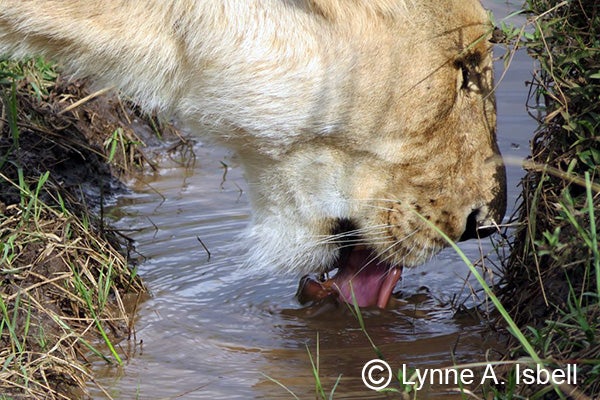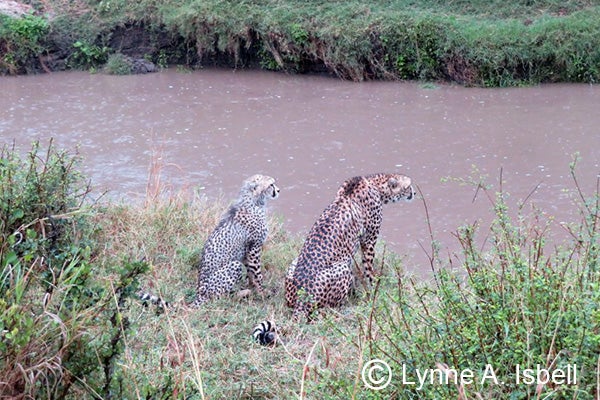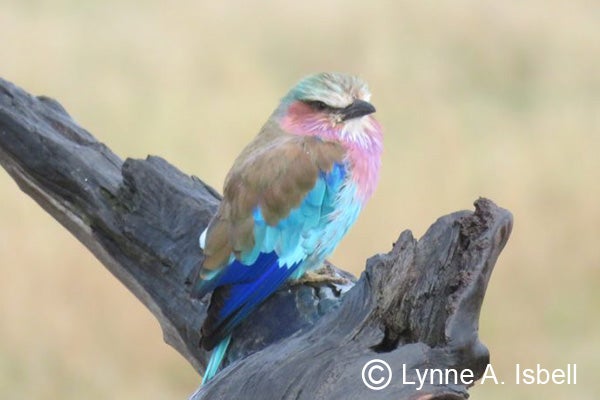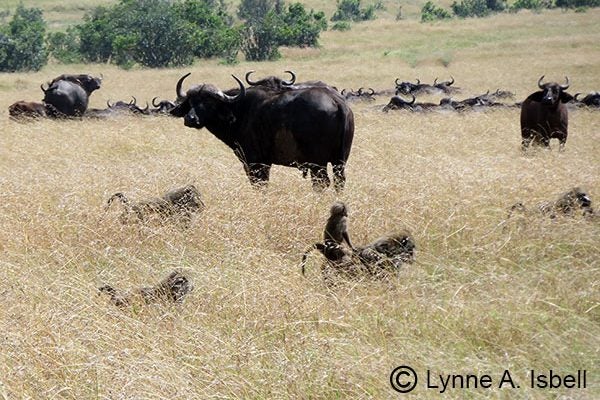




(pdfs in blue)
2024
Isbell, L.A. 2024. Primate Socioecology: Shifting Perspectives. Johns Hopkins University Press, Baltimore, MD.
Isbell, L.A. and Bidner, L. R. 2024. Data from: Study “Leopards, vervets, and baboons in Laikipia, Kenya” [baboons]. Movebank Data Repository (DOI:10.5441/001/1.625).
Loftus, J.C., Ashbury, A., Harel, R., Ashbury A.M., Núñez, C.L., Omondi, G.P., Mutinda, M., Matsumoto-Oda, A., Isbell, L.A., and Crofoot, M.C. 2024. Sharing sleeping sites disrupts sleep but catalyzes social tolerance and coordination between groups. Proceedings of the Royal Society B 291:20241330 (DOI:10.1098/rspb.2024.1330).
Stiegler, J., … Isbell, L.A., … Blaum, N. (99 authors). 2024. Mammals show faster recovery from capture and tagging in human-disturbed landscapes. Nature Communications 15:8079 (DOI:10.1038/s41467-024-52381-8).
2023
Arlet, M.E., Anand, A., Saikia, A., Kaasik, A., Sirigeri, S., Isbell, L.A., & Singh, M. Behavior of mothers after infant loss in bonnet macaques (Macaca radiata). International Journal of Primatology. (DOI: 10.1007/s10764-023-00395-2).
Parker, D.M.,…Isbell, L.A.,…Wilmers, C. (42 authors). The implications of large home range size in a solitary felid. Journal of Mammalogy. (DOI:10.1093/jmammal/gyad074).
Nams, V.O. … Isbell L.A., …Beukes, M. (67 authors). Spatial patterns of two large African cats: a large-scale study on density, home range size, and overlap, of both lions and leopards. Mammal Review 53:49-64 (DOI:10.1111/mam.12309).
2022
Anand, A., Balakrishna, N., Singh, M., Isbell, L.A., Sirigeri, S., Saikia, A., & Arlet, M.E. Infant adoptions in wild bonnet macaques (Macaca radiata). Primates 63:627-635 (DOI:10.1007/s10329-022-01017-w).
Isbell, L.A., Pantaleon, R., & Bradshaw, B. Black, Brown, and White: Stories Straight Outta Compton. Bobely Books, Davis, CA.
Broekman, M., … Isbell, L.A., … Tucker, M.A. (88 authors). Evaluating expert-based habitat suitability information of terrestrial mammals with GPS-tracking data. Global Ecology and Biogeography 31:1526-1541 (DOI:10.1111/geb.13523).
2021
Snider, M.H., Athreya, V.R., Balme, G.A., Bidner, LR., Farhadinia, M.S., Fattebert, J., Gompper, M.E., Gubbi, S., Hunter, L.T.B., Isbell, L.A., Macdonald, D.W., Odden, M., Owen, C.R., Slotow, R., Spalton, J.A., Stein, A.B., Steyn, V., Vanak, A.T., Weise, F.J., Wilmers, C.C., & Kays, R. Home range variation in leopards living across the human density gradient. Journal of Mammalogy 102:1138-1148 (DOI: 10.1093/jmammal/gyab068).
Isbell, L.A., Bidner, L.R., Loftus, J.C., Kimuyu, D., & Young, T.P. Absentee owners and overlapping home ranges in a territorial species. Behavioral Ecology and Sociobiology 75:21 (DOI: 10.1007/s00265-020-02945-7).
Lau, A., Dufek, M.E., Franzetti, T.J., Bales, K.L., & Isbell, L.A. Titi monkey neophobia and visual abilities allow for fast responses to novel stimuli. Scientific Reports 11:2578 (DOI: 10.1038/s41598-021-82116-4).
2020
Suire, A., Isbell, L.A., Bidner, L.R., Shinoda, Y., Akasaka, M., & Matsumoto-Oda, A. Influence of rainfall on sleeping site choice by a group of anubis baboons (Papio anubis). American Journal of Primatology 83:e23223 (DOI: 10.1002/ajp.23223).
Noonan, M., … Isbell, L.A., … & Calabrese, J. (79 co-authors). Effects of body size on estimation of mammalian area requirements. Conservation Biology 34:1017-1028 (DOI: 10.1111.cobi.13495).
2019
Khwaja, H., … Isbell, L.A., … & Challender, D.W.S. (62 authors). Pangolins in global camera trap data: implications for ecological monitoring. Global Ecology and Conservation 20:e00769.
Arlet, G.E., Veromann, L.-L., Isbell, L.A., Mänd, R., & Lemasson, A. Maternal care in free-ranging arboreal grey-cheeked mangabeys (Lophocebus albigena johnstoni) in Kibale National Park, Uganda. Folia Primatologica 90:441-455.
Isbell, L.A., Bidner, L.R., Omondi, G., Mutinda, M., & Matsumoto-Oda, A. Capture, immobilization, and GPS collaring of olive baboons (Papio anubis) and vervets (Chlorocebus pygerythrus): lessons learned and suggested best practices. American Journal of Primatology 81:e22997.
Taniguchi, H., Isbell, L.A., Bidner, L.R., & Matsumoto-Oda, A. Complete rectal prolapse in wild anubis baboons (Papio anubis). Journal of Medical Primatology 48:179-181.
Miller, E.A., Johnson, T.R., Omondi, G., Atwill, E.R., Isbell, L.A., McCowan, B., & VanderWaal, K. Assessing transmission of antimicrobial resistant Escherichia coli in wild giraffe contact networks. Applied and Environmental Microbiology 85:e02136-18.
Linden, J.B., McCowan, B.J., Capitanio, J.P., & Isbell, L.A. Male-inflicted wounds have opposite effects on hair cortisol for captive male and female rhesus macaques (Macaca mulatta) following new group formation. Primates 60:51-62.
2018
Bidner, L.R., Matsumoto-Oda, A., & Isbell, L.A. The role of sleeping sites in the predator-prey dynamics of leopards and olive baboons. American Journal of Primatology 80:e22932.
Linden, J.B., Capitanio, J.P., McCowan, B.J., & Isbell, L.A. Coping style and cortisol levels in infancy predict hair cortisol following new group formation in captive rhesus macaques (Macaca mulatta). American Journal of Primatology 80:e22938.
Van Cleave, E., Bidner, L.R., Ford, A.T., Caillaud, D.C., Wilmers, C.C., & Isbell, L.A. Diel patterns of movement activity and habitat use by leopards (Panthera pardus pardus) living in a human-dominated landscape in central Kenya. Biological Conservation 226:224-237.
Isbell, L.A., Bidner, L.R., Van Cleave, E.K., Matsumoto-Oda, A., & Crofoot, M.C. GPS-identified vulnerabilities of savannah-woodland primates to leopard predation and their implications for early hominins. Journal of Human Evolution 118:1-13.
Tucker, M.A., … Isbell, L.A., … Mueller, T. (114 co-authors). 2018. Moving in the Anthropocene: global reductions in terrestrial mammalian movements. Science 359:466-469.
Isbell, L.A. Grouping patterns in nonhuman primates. In The International Encyclopedia of Biological Anthropology. (W. Trevathan, ed.), pp. 676-677. John Wiley and Sons, Inc.
Isbell, L.A. Socioecological model. In The International Encyclopedia of Biological Anthropology (W. Trevathan, ed.), pp. 1441-1444. John Wiley and Sons, Inc.
2017
Wilmers, C.C., Isbell, L.A., Suraci, J., & Williams, T.M. Energetics-informed behavioral states reveal the drive to kill in African leopards. Ecosphere. DOI: 10.1002/ecs2.1850
Isbell, L.A., Bidner, L.R., Crofoot, M.C., Matsumoto-Oda, A., & Farine, D.R. GPS-identified, low-level nocturnal activity of vervets (Chlorocebus pygerythrus) and olive baboons (Papio anubis) in Laikipia, Kenya. American Journal of Physical Anthropology 164:203-211.
Isbell, L.A. Hrdy, Sarah Blaffer. In The International Encyclopedia of Primatology (A. Fuentes, ed.). John Wiley and Sons. DOI: 10.1002/9781119179313.wbprim0297
Isbell, L.A. Socioecological model. In The International Encyclopedia of Primatology (A. Fuentes, ed.). John Wiley and Sons. DOI: 10.1002/9781119179313.wbprim0028
Isbell, L.A. Grouping patterns. In The International Encyclopedia of Primatology (A. Fuentes, ed.). John Wiley and Sons. DOI: 10.1002/9781119179313.wbprim0029
Porter A.M., Grote M.N., Isbell, L.A., Fernandez-Duque, E., & Di Fiore, A. Delayed dispersal and immigration in equatorial sakis (Pithecia aequatorialis): factors in the transition from pair- to group-living. Folia Primatologica 88:11-27.
Van Strien, J.W. & Isbell, L.A. Snake scales, partial exposure, and the Snake Detection Theory: A human ERP study. Scientific Reports 7:46331 | doi.org/10.1038/srep46331.
Soares S.C., Maior R.S., Isbell, L.A., Tomaz, C., & Nishijo H. Fast detector/first responder: interactions between the superior colliculus-pulvinar pathway and stimuli relevant to primates. Frontiers in Neuroscience: Systems Biology 11:67 | doi.org/10.3389/fnins.2017.00067.
Isbell, L.A. & Etting, S.F. Scales drive visual detection, attention, and memory of snakes in wild vervet monkeys (Chlorocebus pygerythrus). Primates 58:121-129.
2016
Isbell, L.A. & Bidner, L.R. 2016. Vervet monkey (Chlorocebus pygerythrus) alarm calls to leopards (Panthera pardus) function as a predator deterrent. Behaviour 153:591-606.
VanderWaal, K.L., Obanda, V.O., Omondi, G.P., McCowan, B., Wang, H., Fushing, H., & Isbell, L.A. The “strength of weak ties” and helminth infection in giraffe social networks. Behavioral Ecology 27:1190-1197.
Le, Q.V., Isbell, L.A., Matsumoto, J., Le, V.Q., Nishimaru, H., Hori, E., Maior, R.S., Tomaz, C., Ono, T., & Nishijo, H. Snakes elicit earlier, and monkey faces, later, gamma oscillations in macaque pulvinar neurons. Scientific Reports 6:20595.
2015
Porter A.M., Grote M.N., Isbell, L.A., Fernandez-Duque, E., & Di Fiore, A. A saki saga: dynamic and disruptive relationships among Pithecia aequatorialis in eastern Ecuador, and functions of multiple adult males in saki groups. Folia Primatologica 86:455-473.
Arlet, M.E., Isbell, L.A., Kaasik A., Molleman, F., Chancellor, R.L., Chapman, C.A., Mänd, R., & Carey, J.R. Determinants of reproductive performance among female gray-cheeked mangabeys (Lophocebus albigena) in Kibale National Park, Uganda. International Journal of Primatology 36:55-73.
Arlet, M.E., Chapman, C.A., Isbell, L.A., Molleman, F., Mänd, R., Hõrak, P, & Carey, J.R. Social and ecological correlates of parasitic infections in adult male gray-cheeked mangabeys (Lophocebus albigena). International Journal of Primatology 36:967-986.
2014
Le Q.V., Isbell, L.A., Matsumoto, J., Quang, L.V., Hori, E., Tran, A.H., Maior, R.S., Tomaz, C., Ono, T., & Nishijo, H. Monkey pulvinar neurons fire differentially to snake postures. PLoS ONE 9:e114258. doi:10.1371/journal.pone.0114258.
Etting, S.F. & Isbell, L.A. Rhesus macaques (Macaca mulatta) use snake posture to assess level of threat. Ethology 120:1177-1184.
Ford, A.T., Goheen, J.R., Otieno, T.O., Bidner, L., Isbell, L.A., Palmer, T.M., Ward, D., Woodroffe, R., & Pringle, R.M. Large carnivores make savanna tree communities less thorny. Science 346:346-349.
Arlet, M.E., Isbell, L.A., Molleman, F., Kaasik, A., Chancellor, R.L., Chapman, C.A., Mänd, R., & Carey, J.R. Maternal investment and infant survival in gray-cheeked mangabeys (Lophocebus albigena). International Journal of Primatology 35:476-490.
Etting, S.F., Isbell, L.A., & Grote, M.N. Factors increasing snake detection and perceived threat in captive rhesus macaques (Macaca mulatta).American Journal of Primatology 76:135-145.
VanderWaal, K.L., Atwill, E.R., Isbell, L.A., & McCowan, B. Linking social and pathogen transmission networks using microbial genetics in giraffe (Giraffa camelopardalis). Journal of Animal Ecology 83:406-414.
VanderWaal, K.L., Wang, H., McCowan, B., Fushing, H., & Isbell, L.A. Multi-level social organization and space use in reticulated giraffe (Giraffa camelopardalis). Behavioral Ecology 25:17-26.
VanderWaal, K.L., Atwill, E.R., Isbell, L.A., & McCowan, B. Quantifying pathogen transmission networks in wild and domestic ungulates in Kenya. Biological Conservation 169:136-146.
2013
Le, Q.V., Isbell, L.A., Nguyen, M.N., Matsumoto J., Hori, E., Maior, R.S., Tomaz, C., Tran, A.H., Ono, T., & Nishijo, H. Pulvinar neurons reveal neurobiological evidence of past selection for rapid detection of snakes. Proceedings of the National Academy of Sciences 110:19000-19005.
Arlet, M.E., Molleman, F., Isbell, L.A., Chancellor, R.L., Carey, J.R., & Mänd, R. Correlations between social context and fecal glucocorticoid metabolite concentrations in free-ranging female gray-cheeked mangabeys (Lophocebus albigena) in Kibale National Park, Uganda. Folia Biologica 61:239-246.
Isbell, L.A. Erythrocebus patas Patas monkey. In The Mammals of Africa: Vol. II Primates (T.M. Butynski, J.S. Kingdon, and J. Kalina, eds.). Bloomsbury Publishing, London, pp. 257-264.
Isbell, L.A. & Jaffe, K.L.E. Chlorocebus pygerythrus Vervet monkey. In The Mammals of Africa: Vol II Primates (T.M. Butynski, J.S. Kingdon, and J. Kalina, eds.). Bloomsbury Publishing, London, pp. 277-283.
Isbell, L.A., Rothman, J.M., Young, P.J., & Rudolph, K. Nutritional benefits of Crematogaster mimosae ants and Acacia drepanolobium gum for patas monkeys and vervets in Laikipia, Kenya. American Journal of Physical Anthropology 150:286-300.
2012
Isbell, L.A., Young, T.P., & Harcourt, A.H. Stag parties linger: continued gender bias in a female-rich scientific discipline. PLoS ONE 7:e49682.http://www.plosone.org/article/info%3Adoi%2F10.1371%2Fjournal.pone.0049682
Isbell, L.A. Re-evaluating the Ecological Constraints model with red colobus monkeys (Procolobus rufomitratus tephrosceles). Behaviour 149:493-529.
2011
Bunce, J.A., Isbell, L.A., Grote M.N., & Jacobs, G. Color vision variation and foraging behavior in wild Neotropical titi monkeys (Callicebus brunneus): possible mediating roles for spatial memory and reproductive status. International Journal of Primatology 32:1058–1075.
Adiseshan, A., Adiseshan, T., & Isbell, L.A. Affiliative relationships and reciprocity among adult male bonnet macaques (Macaca radiata) at Arunachala Hill, India. American Journal of Primatology 73:1107-1113.
Beisner, B.A. & Isbell, L.A. Factors affecting aggression among females in captive groups of rhesus macaques (Macaca mulatta). American Journal of Primatology 73:1152-1159.
Arlet, A.E., Kaasik, A., Molleman, F., Isbell, L.A., Carey, J.R., & Mänd, R. Social factors increase fecal testosterone levels in wild male gray-cheeked mangabeys (Lophocebus albigena). Hormones and Behavior 59:605-611.
Jaffe, K.E. & Isbell, L.A. The guenons: polyspecific associations in socioecological context. In Primates in Perspective, 2nd Edition (C.J. Campbell, A. Fuentes, K.C. MacKinnon, S.K. Bearder, and R.M. Stumpf, eds.). Oxford University Press, New York, pp. 277-300.
Bunce, J.A., Isbell, L.A., Neitz, M., Bonci, D., Surridge, A., Jacobs, G., & Smith, D.G. Characterization of opsin gene alleles affecting color vision in a wild population of titi monkeys (Callicebus brunneus). American Journal of Primatology 73:189-196.
2010
Jaffe, K.E. & Isbell, L.A. Ranging and social behavior after a predator-induced group fusioin in wild vervet monkeys (Cercopithecus aethiops) in Laikipia, Kenya. American Journal of Primatology 72:634-644.
2009
Isbell, L.A. The Fruit, the Tree, and the Serpent: Why We See So Well. Harvard University Press, Cambridge, MA.
Beisner, B.A. & Isbell, L.A. Movement ecology in a captive environment: the effects of ground substrate on captive rhesus macaques, Macaca mulatta. Animal Behaviour 78:1269-1277.
Chancellor, R.L. & Isbell, L.A. Food site residence time and female competitive relationships in wild gray-cheeked mangabeys (Lophocebus albigena). Behavioral Ecology and Sociobiology 63:1447-1258.
De Jong, Y.A., Butynski, T.M., Isbell, L.A., & Lewis, C. Decline of the geographical range of the southern patas monkey Erythrocebus patas baumstarki in Tanzania. Oryx 43:267-274.
Beisner, B.A. & Isbell, L.A. Factors influencing hair loss among captive rhesus macaques (Macaca mulatta). Applied Animal Behaviour Science 119:91-100.
Pinter-Wollman, N., Isbell, L.A., & Hart, L.A. Assessing translocation outcome: comparing behavioral and physiological aspects of translocated and resident African elephants (Loxodonta africana). Biological Conservation 142:1116-1124.
Jack, K.M. & Isbell, L.A. Dispersal in primates: advancing an individualized approach. Behaviour 146:429-436.
Schoof, V.A.M., Jack, K.M., & Isbell, L.A. What traits promote male parallel dispersal in primates? Behaviour 146:701-726.
Isbell, L.A., Young,T.P., Jaffe, K.E., Carlson, A.A., & Chancellor, R.L. Demography and life histories of sympatric patas monkeys (Erythrocebus patas) and vervets (Cercopithecus aethiops) in Laikipia, Kenya. International Journal of Primatology 30:103-124.
Pinter-Wollman, N., Isbell, L.A., & Hart, L.A. The relationship between social behavior and habitat familiarity in African elephants (Loxodonta africana). Proceedings of the Royal Society B 276:1009-1014.
Arlet, M.E. & Isbell, L.A. Variation in behavioral and hormonal responses of adult male gray-cheeked mangabey (Lophocebus albigena) to crowned eagles (Stephanoaetus coronatus) in Kibale National Park, Uganda. Behavioral Ecology and Sociobiology 63:491-199.
Jaffe, K.E. & Isbell, L.A. After the fire: benefits of reduced ground cover for vervet monkeys (Cercopithecus aethiops). American Journal of Primatology 71:252-260.
Chancellor, R.L. & Isbell, L.A. Female grooming markets in a population of gray-cheeked mangabeys (Lophocebus albigena). Behavioral Ecology 20:79-86.
Arlet, M.E., Grote, M., Molleman, F., Isbell, L.A., & Carey, J.R. Reproductive tactics influence cortisol levels in individual male gray-cheeked mangabeys (Lophocebus albigena). Hormones and Behavior 55:210-216.
2008
Beisner, B.A. & Isbell, L.A. Ground substrate affects activity budgets and hair loss in captive outdoor-housed rhesus macaques (Macaca mulatta). American Journal of Primatology 70:1160-1168.
Off, E.C., Isbell, L.A., & Young, T.P. Population density and habitat preferences of the Kenya lesser galago (Galago senegalensis braccatus Elliot, 1907) along the Ewaso Nyiro River, Kenya Journal of East African Natural History 97:109-116.
Chancellor, R.L. & Isbell, L.A. Punishment and competition over food in captive rhesus macaques, Macaca mulatta. Animal Behaviour 75:1939-1947.
2007
Isbell, L.A. & Young, T.P. Interspecific and temporal variation of ant species within Acacia drepanolobium ant domatia, a staple food of patas monkeys (Erythrocebus patas) in Laikipia, Kenya. American Journal of Primatology 69:1387-1398.
Isbell, L.A. & Chism, J. Distribution and abundance of patas monkeys (Erythrocebus patas) in Laikipia, Kenya, 1979-2004. American Journal of Primatology 69:1223-1235.
2006
Isbell, L.A. Snakes as agents of evolutionary change in primate brains. Journal of Human Evolution 51:1-35.
Isbell, L.A. Live fast, die young. National Wildlife June/July:29K-36K.
Isbell, L.A. Snakes on the brain. New York Times (3 September, Section 4:10).
2004
Isbell, L.A. Is there no place like home? Ecological bases of dispersal in primates and their consequences for the formation of kin groups. In:Kinship and Behavior in Primates (Chapais, B. & Berman, C., eds.). Oxford University Press, New York, pp. 71-108.
Enstam, K.L. & Isbell, L.A. Microhabitat preference and vertical use of space by patas monkeys (Erythrocebus patas) in relation to predation risk and habitat structure. Folia Primatologica 75:70-84.
2003
Laurent, P., Hamdani, A., Braekman, J.-C., Daloze, D., Isbell, L.A., de Biseau, J.-C., & Pasteels, J.M. New 1-alk(en)yl-1,1,3,5-trihydroxycyclohexanes from the Dufour gland of the African ant Crematogaster nigriceps. Tetrahedron Letters 44:1383-1386.
2002
Isbell, L.A., Cheney, D.L., & Seyfarth, R.M. Why vervets (Cercopithecus aethiops) live in multi-male groups. In: The Guenons: Diversity and Adaptation in African Monkeys (Glenn, M. & Cords, M., eds.), Kluwer Academic/Plenum Press, New York, pp. 173-187.
Enstam, K.L. & Isbell, L.A. Comparison of responses to alarm calls by patas (Erythrocebus patas) and vervet (Cercopithecus aethiops) monkeys in relation to habitat structure. American Journal of Physical Anthropology 119:3-14.
Isbell, L.A. & Young, T.P. Ecological models of female social relationships in primates: similarities, disparities, and some directions for future clarity. Behaviour 139:177-202.
Enstam, K.L., Isbell, L.A. & De Maar, T. Male demography, female mating behaviour, and infanticide in wild patas monkeys (Erythrocebus patas). International Journal of Primatology 23:85-104.
Isbell, L.A. & Enstam, K.L. Predator (in)sensitive foraging in sympatric vervets (Cercopithecus aethiops) and patas monkeys (Erythrocebus patas): a test of ecological models of group dispersion. In: Eat or Be Eaten: Predation-Sensitive Foraging in Primates (Miller, L.E., ed.), Cambridge University Press, Cambridge, pp. 154-168.
2001
Carlson, A.A. & Isbell, L.A. Causes and consequences of single-male and multi-male mating in free-ranging patas monkeys (Erythrocebus patas).Animal Behaviour 62:1047-1058.
Mathy, J. & Isbell, L.A. The relative importance of size of food and interfood distance in eliciting aggression in captive rhesus macaques (Macaca mulatta). Folia Primatologica 72:268-277.
Garraffo, H.M., Spande, T.F., Jain, P., Kaneko, T., Jones, T.H., Blum, M.S., Ali, T.M.M., Snelling, R.R., Isbell, L.A., Robertson, H.G., & Daley, J.W. Ammonia chemical ionization-tandem mass spectrometry in structure determination of alkaloids, II. Tetraponerines from pseudomymecine ants. Rapid Communications in Mass Spectrometry 15:1409-1415.
2000
Pruetz, J.D. & Isbell, L.A. Correlations of food distribution and patch size with agonistic interactions in female vervets (Chlorocebus aethiops) and patas monkeys (Erythrocebus patas) living in simple habitats. Behavioral Ecology and Sociobiology 49:38-47.
1999
Isbell, L.A., Pruetz, J.D., Lewis, M., & Young, T.P. Rank differences in ecological behavior: a comparative study of patas monkeys (Erythrocebus patas) and vervets (Cercopithecus aethiops). International Journal of Primatology 20:257-272.
Isbell, L.A., Pruetz, J.D., Nzuma, B.M., & Young, T.P. Comparing measures of travel distances in primates: methodological considerations and socioecological implications. American Journal of Primatology 48:87-98.
1998
Isbell, L.A. & Pruetz, J.D. Differences between vervets (Cercopithecus aethiops) and patas monkeys (Erythrocebus patas) in agonistic interactions between adult females. International Journal of Primatology 19:837-855.
Isbell, L.A. Diet for a small primate: insectivory and gummivory in the (large) patas monkey (Erythrocebus patas pyrrhonotus). American Journal of Primatology 45:381-398.
Isbell, L.A., Pruetz, J.D., Lewis, M., & Young, T.P. Locomotor activity differences between sympatric patas monkeys (Erythrocebus patas) and vervet monkeys (Cercopithecus aethiops): implications for the evolution of long hindlimb length in Homo. American Journal of Physical Anthropology 105:199-207.
Isbell, L.A., Pruetz, J.D., & Young, T.P. Movements of vervets (Cercopithecus aethiops) and patas monkeys (Erythrocebus patas) as estimators of food resource size, density, and distribution. Behavioral Ecology and Sociobiology 42:123-133.
1997
Young, T.P., Stubblefield, C., & Isbell, L.A. Ants on swollen-thorn acacias: species coexistence in a simple system. Oecologia 109:98-107.
1996
Isbell, L.A. East Africa: the cradle of humanity. In: Ecosystems of East Africa and their Conservation (McClanahan, T.R. & Young, T.P., eds.). Oxford University Press, New York, pp. 20-21.
Isbell, L.A. & Young, T.P. The evolution of bipedalism in hominids and reduced group size in chimpanzees: alternative responses to decreasing resource availability. Journal of Human Evolution 30:389-397.
Isbell, L.A. & Van Vuren, D. Differential costs of locational and social dispersal and their consequences for female group-living primates.Behaviour 133:1-36.
1995
Isbell, L.A. Seasonal and social correlates of changes in hair, skin, and scrotal condition in vervet monkeys (Cercopithecus aethiops) of Amboseli National Park, Kenya. American Journal of Primatology 36:61-70.
1994
Isbell, L.A. Predation on primates: ecological patterns and evolutionary consequences. Evolutionary Anthropology 3:61-71.
Isbell, L.A. The vervets’ year of doom. Natural History 103(8):48-55.
Young, T.P. & Isbell, L.A. Minimum group size and other conservation lessons exemplified by a declining primate population. Biological Conservation 68:129-134.
1993
Isbell, L.A. & Young, T.P. Social and ecological influences on activity budgets of vervet monkeys, and their implications for group living.Behavioral Ecology and Sociobiology 32:277-385.
Isbell, L.A. & Young, T.P. Human presence reduces predation in a free-ranging vervet monkey population in Kenya. Animal Behaviour 45:1233-1235.
Isbell, L.A., Cheney, D.L., & Seyfarth, R.M. Are immigrant vervet monkeys, Cercopithecus aethiops, at greater risk of mortality than residents? Animal Behaviour 45:729-734.
1991
Young, T.P. & Isbell, L.A. Sex differences in giraffe feeding ecology: energetic and social constraints. Ethology 87:79-89.
Isbell, L.A. Contest and scramble competition: patterns of female aggression and ranging behavior among primates. Behavioral Ecology 2:143-155.
Isbell, L.A., Cheney, D.L., & Seyfarth, R.M. Group fusions and minimum group sizes in vervet monkeys (Cercopithecus aethiops). American Journal of Primatology 25:57-65.
1990
Isbell, L.A., Cheney, D.L., & Seyfarth, R.M. Costs and benefits of home range shifts among vervet monkeys (Cercopithecus aethiops) in Amboseli National Park, Kenya. Behavioral Ecology and Sociobiology 27:361-358.
Isbell, L.A. Sudden short-term increase in mortality of vervet monkeys (Cercopithecus aethiops) due to leopard predation in Amboseli National Park, Kenya. American Journal of Primatology 21:41-52.
1983
Isbell, L.A. Daily ranging behavior of red colobus (Colobus badius tephrosceles) in Kibale Forest, Uganda. Folia Primatologica 41:34-48.
Isbell, L.A. & Skorupa, J.P. Raiders in the dark. Animal Kingdom 6-7:12-14.
